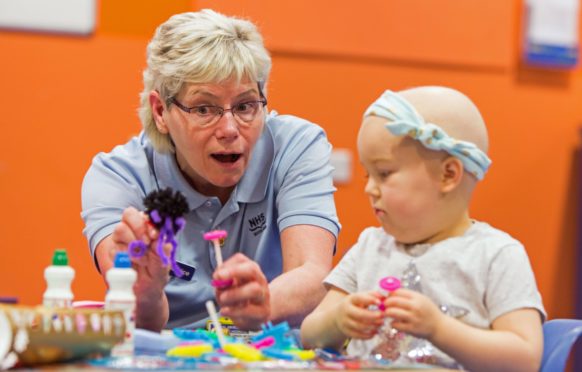Every day is different for Maureen McDonald, who has come up with increasingly inventive ways to help her patients over the years.
In the morning, she might help a scared youngster roar like a lion, in order to feel brave for surgery.
Then it’s out on to the wards to make sure even the youngest patients are getting enough stimulation.
Were it not for Maureen and a dedicated team of play specialists at Royal Aberdeen Children’s Hospital, many patients might be left feeling anxious and unsure.
Her role as a play specialist means she helps children who may be facing major surgery, and Maureen also prepares parents and siblings for the long road ahead.
Something as straightforward as a blood test can appear terrifying to a child, but Maureen has dozens of tricks up her sleeve.
She is routinely called upon by a wide range of staff, and consultants can also refer children to a play specialist.
Her work has been highlighted in a new documentary series called The Children’s Hospital, which goes behind the scenes in Aberdeen.
There are almost 600 staff who treat thousands of patients every year.
In episode one, which aired on Wednesday, Maureen helped, four-year-old, Jack conquer his fear of needles.
When Jack was born he was diagnosed with a liver disease, and he received a life-saving liver transplant at just three weeks old.
He has regular blood tests to check his liver is working, but developed a phobia of needles.
“In Jack’s case it was a question of making needles seem less scary,” said Maureen.
“Every single child is different, so you have to come up with an approach which will suit them.
“You never tell a child to play; you might put together a painting table and wait to see if they are interested.
“I’ve worked in the hospital for 20 years and I have been a play specialist since 2006.
“There is a team of us and we use play to help children.
“We can see children from birth to the age of 18.
“We have a very wide case load as well.
“We deal with patients who may be coming in for the day, or those who are with us for longer.”
Maureen’s work is particularly vital for patients who may be in hospital for weeks or even months at a time.
“We try and replicate how a child would play at home,” said Maureen.
“It is proven that play can help a child through recovery, and children learn through play.
“Play can enable children to feel that they have control in a situation where control has been taken away from them.
“Even if a child is very young, play is important for their development.
“There isn’t much stimulation if you’re in a cot attached to wires, we try and help as best we can.”
Due to Maureen’s years of service on the wards, she also gets the chance to catch up with patients who have become parents themselves.
“Sometimes I bump into an old patient of mine, and they come into the hospital with their own child,” she said.
“They often remember me and I find that really lovely.”
But how do you help a child not feel scared, especially when a big operation lies ahead?
Messy play is a particular favourite with some children, and Maureen also enjoys playing board games with patients.
“It gives us the opportunity to talk about things,” she said.
“Sometimes youngsters come to me in their early teens, I’m not going to be getting pots of playdough out.
“As a team we all compare notes on what may have worked for a patient in the past.
“We’re always coming up with new ideas.
“If a child wants us to be there when they have an MRI scan, we will be.
“We will already have done a lot of emotional work to prepare them for lying still.
“Children never fail to surprise me, and in a situation which might be difficult for them, they can cope wonderfully.
“Some patients tell me they were a superstar when they were getting blood taken, and I can’t help but agree.
“Other times a child will be referred to me because they aren’t coping well at all.
“We can help the entire family, from siblings to parents.
“It can be a really overwhelming time, but we can put together coping methods. That’s a big part of our job.”
Maureen and the team also have a very important role to play at Christmas time.
“Obviously the staff have to contact Santa to make sure each child wakes up to a present on Christmas morning,” she said.
“It’s just brilliant and the hospital is a wonderful place to work.
“We work very closely with the doctors and nurses, we’re one big team.
“We’re all working towards the same goal.
“To make the experience as positive as possible.”
The Children’s Hospital airs on BBC Scotland on Wednesday at 8pm.
